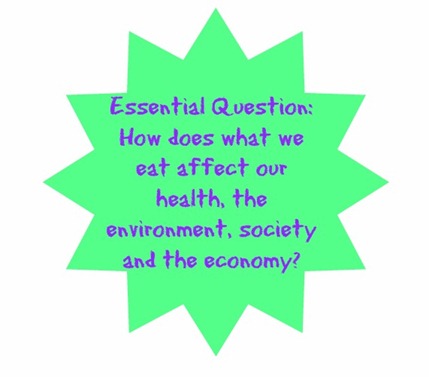Once again I am merging the two concepts upon which this blog was designed- my love of food and my teaching career. I already posted awhile back about incorporating my love of food into my classroom. To end the year, my students are completing a research project centered around an amazing book I just finished, which was life changing to say the least.
In his book, Pollan strives to uncover secrets of industrial, processed, industrial organic, and sustainable meals. It really goes to the heart of how what you eat affects not only you, but the environment, the economy, the government, and society as a whole. As bloggers, we may put a lot of thought into what we eat. But have you REALLY thought of the political, social, environmental and economical implications of eating your morning cereal? Who grew, processed, packaged and shipped that product? Did it take more energy to make it than you can actually get from it? The answers will surprise you, and most likely make you NOT want to eat a lot of the things you currently eat. I know I’ve changed my eating habits immensely since reading this book.
So I was reading this book and come to find out…..it’s on the common core for 8th grade! Who would have thought?!?! My initial reaction was excitement. Then it turned immediately to panic. They want 8th graders to read this?!?!? One of the chapters was labeled “corn sex” !!! There were words I couldn’t pronounce. I was freaking out. Then I discovered this:
The young adult version! Essentially the same book only at a lower, much easier to understand reading level (I was struggling to follow the adult version myself!). And no sex, even of the corn nature.
I picked out about 5 chapters for students to read to get an overall picture in order to answer this question:
Students did various activities examining food labels, watching videos provided by Nourish, and studied industrial faming VS local farming.
It just really surprised me how little my students knew about the secrets behind the food they eat. That soda is mostly 100% HFCS. That they put ammonia in meat to kill bacteria. The environmental implications of drinking hot chocolate that was shipped from Switzerland.
There’s so much to talk about when it comes to this topic (I already covered eating local). At some times I was feeling weird about teaching students this, thinking they were going to go home and rant to their parents about how they need to start eating grass-fed beef. But if you really think about it, if we don’t teach our kids about this damaging, corrupt, and disgusting thing that is the food industry, when will the ignorance end?
SO when we were done studying the topic, students picked their own individual topics to research further. Choices included:
*Organic vs conventional food
*Food poisoning
*grass fed vs industrial meat
*processed food
*fast food secrets (a popular one)
*hunting for food
*Hidden ingredients
Students will do research (we’re wrapping up day 3 of research) and then complete a presentation (no paper- aren’t I nice?) using the Ipad app Haiku Deck. This presentation software is really easy to use, student friendly, and eye catching! It’s similar to power point but much more simple. Perfect for our shortened time frame.

Can’t wait to post some examples!
You should really get your hands on the adult (or young adult!) version of the book. It changed the way I look at food forever. I obviously ate pretty healthy before this book, but some of the things you think to believe are “healthy” have some compromising implications you’d be surprised about. Check it out!!!
Have you read the book? Do you think we should teach our kids to care about where our food comes from?

![IMG_2519[1] IMG_2519[1]](https://aburgwin.wordpress.com/wp-content/uploads/2013/05/img_25191_thumb.jpg?w=260&h=347)

![IMG_0511[1] IMG_0511[1]](https://aburgwin.wordpress.com/wp-content/uploads/2013/05/img_05111_thumb.jpg?w=500&h=376)


![IMG_2339[1] IMG_2339[1]](https://aburgwin.wordpress.com/wp-content/uploads/2013/05/img_23391_thumb.jpg?w=331&h=331)
![IMG_2411[1] IMG_2411[1]](https://aburgwin.wordpress.com/wp-content/uploads/2013/05/img_24111_thumb.jpg?w=337&h=252)

